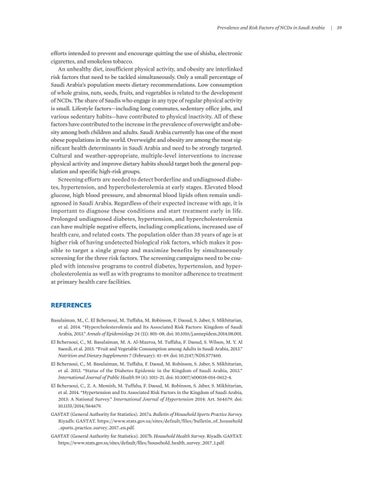Prevalence and Risk Factors of NCDs in Saudi Arabia | 39
efforts intended to prevent and encourage quitting the use of shisha, electronic cigarettes, and smokeless tobacco. An unhealthy diet, insufficient physical activity, and obesity are interlinked risk factors that need to be tackled simultaneously. Only a small percentage of Saudi Arabia’s population meets dietary recommendations. Low consumption of whole grains, nuts, seeds, fruits, and vegetables is related to the development of NCDs. The share of Saudis who engage in any type of regular physical activity is small. Lifestyle factors—including long commutes, sedentary office jobs, and various sedentary habits—have contributed to physical inactivity. All of these factors have contributed to the increase in the prevalence of overweight and obesity among both children and adults. Saudi Arabia currently has one of the most obese populations in the world. Overweight and obesity are among the most significant health determinants in Saudi Arabia and need to be strongly targeted. Cultural and weather-appropriate, multiple-level interventions to increase physical activity and improve dietary habits should target both the general population and specific high-risk groups. Screening efforts are needed to detect borderline and undiagnosed diabetes, hypertension, and hypercholesterolemia at early stages. Elevated blood glucose, high blood pressure, and abnormal blood lipids often remain undiagnosed in Saudi Arabia. Regardless of their expected increase with age, it is important to diagnose these conditions and start treatment early in life. Prolonged undiagnosed diabetes, hypertension, and hypercholesterolemia can have multiple negative effects, including complications, increased use of health care, and related costs. The population older than 35 years of age is at higher risk of having undetected biological risk factors, which makes it possible to target a single group and maximize benefits by simultaneously screening for the three risk factors. The screening campaigns need to be coupled with intensive programs to control diabetes, hypertension, and hypercholesterolemia as well as with programs to monitor adherence to treatment at primary health care facilities.
REFERENCES Basulaiman, M., C. El Bcheraoui, M. Tuffaha, M. Robinson, F. Daoud, S. Jaber, S. Mikhitarian, et al. 2014. “Hypercholesterolemia and Its Associated Risk Factors: Kingdom of Saudi Arabia, 2013.” Annals of Epidemiology 24 (11): 801–08. doi: 10.1016/j.annepidem.2014.08.001. El Bcheraoui, C., M. Basulaiman, M. A. Al-Mazroa, M. Tuffaha, F. Daoud, S. Wilson, M. Y. Al Saeedi, et al. 2015. “Fruit and Vegetable Consumption among Adults in Saudi Arabia, 2013.” Nutrition and Dietary Supplements 7 (February): 41–49. doi: 10.2147/NDS.S77460. El Bcheraoui, C., M. Basulaiman, M. Tuffaha, F. Daoud, M. Robinson, S. Jaber, S. Mikhitarian, et al. 2013. “Status of the Diabetes Epidemic in the Kingdom of Saudi Arabia, 2013.” International Journal of Public Health 59 (6): 1011–21. doi: 10.1007/s00038-014-0612-4. El Bcheraoui, C., Z. A. Memish, M. Tuffaha, F. Daoud, M. Robinson, S. Jaber, S. Mikhitarian, et al. 2014. “Hypertension and Its Associated Risk Factors in the Kingdom of Saudi Arabia, 2013: A National Survey.” International Journal of Hypertension 2014: Art. 564679. doi: 10.1155/2014/564679. GASTAT (General Authority for Statistics). 2017a. Bulletin of Household Sports Practice Survey. Riyadh: GASTAT. https://www.stats.gov.sa/sites/default/files/ bulletin_of_household _sports_practice_survey_2017_en.pdf. GASTAT (General Authority for Statistics). 2017b. Household Health Survey. Riyadh: GASTAT. https://www.stats.gov.sa/sites/default/files/household_health_survey_2017_1.pdf.

